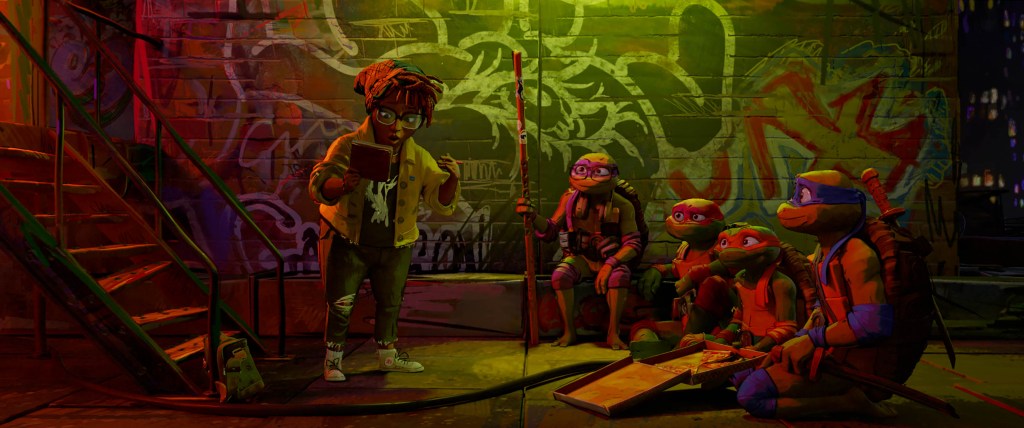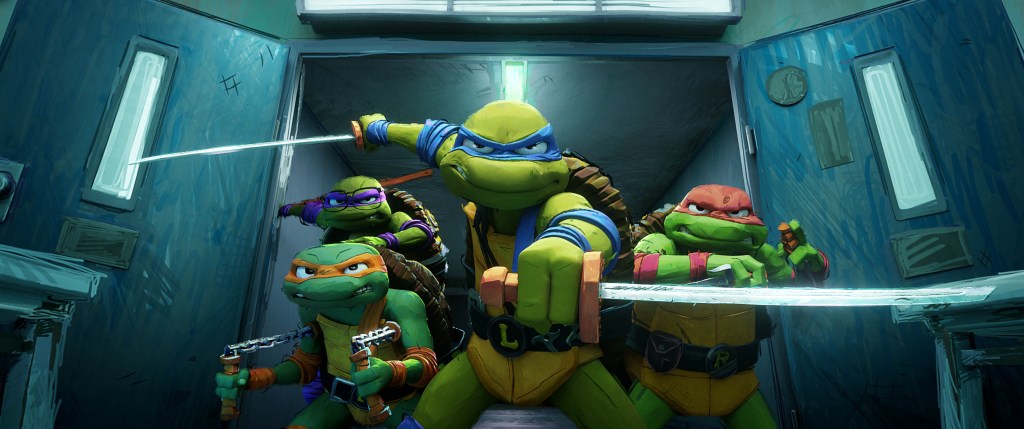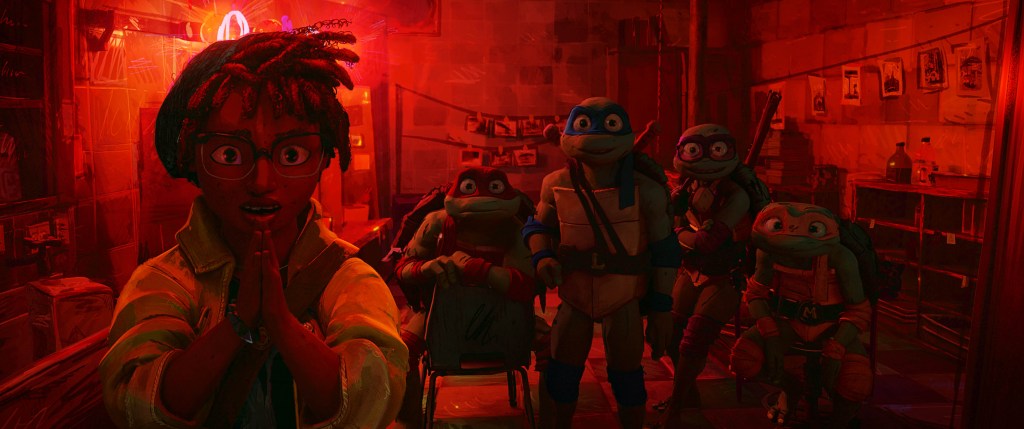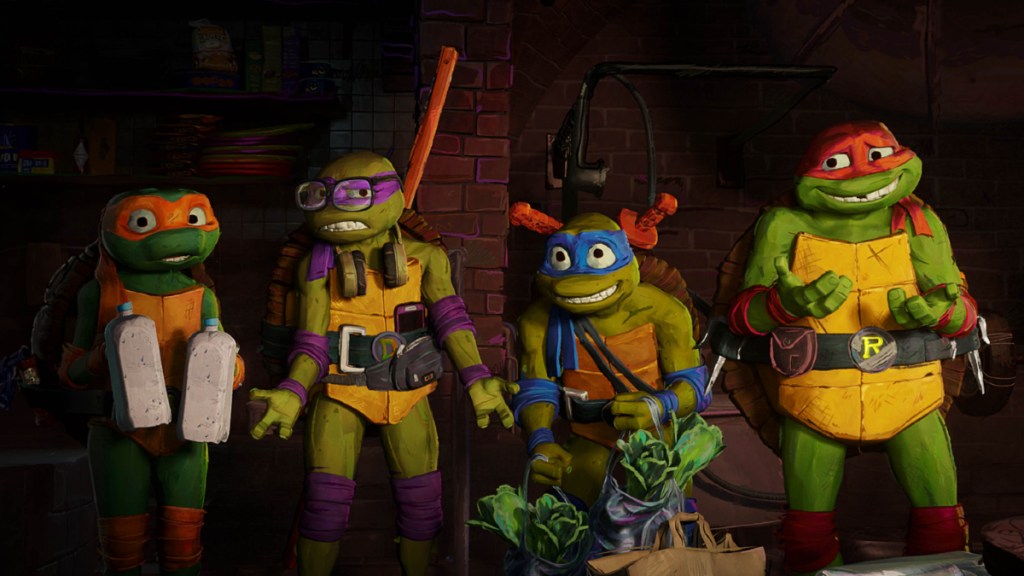Teenage Mutant Ninja Turtles: Mutant Mayhem may be no Spider-Verse, but the fact that it even tries to be puts it way above the level of so much family animation these days. Using an animation style that feels like a haphazardly blended smoothie of MTV’s Liquid Television, Duckman, Lynda Barry, and The Mitchells vs. the Machines, it goes for broke with distinctive visuals. Your eyes may even feel broken at first — it takes a while to adjust to the 3D-looking-like-2D, where everything looks flat if nothing moves, then comes to life the moment action occurs, like one of those computer-created depth perception illusions the second your brain finally clicks and sees it.

The World’s Most Fearsome Fighting Team
The most successful non-DC, non-Marvel superheroes of all time, the Renaissance-artist-monikered Turtles are so ingrained in the cultural consciousness and so familiar to moviegoers (five live-action movies, one animated prior to this, and counting) that it’s time for at least a mildly different approach. So some things have changed: Splinter’s no longer Asian (despite Jackie Chan doing his voice), April (Ayo Edebiri) is in high school and terrified of appearing on camera; and Baxter Stockman (Giancarlo Esposito), rather than being a human fly, is now a human with an adopted mutant fly as his son.
Said insect, who grows to be known as Superfly and is voiced by Ice Cube, serves as the film’s primary antagonist, even as it’s clear there are other dark forces gathering for a sequel. Angered by his father’s treatment by higher-ups, Superfly plans to pull a Magneto and create a ray that kills all humans while making every animal on Earth into a super mutant humanoid. (As a carnivore, even a carrion one, he seems not to have considered the obvious flaw in that logic. Chowing down on the corpses of sapient allies would surely be bad form.)

Part of Which World?
For the Turtles who, Little Mermaid-like, want to be where the people are, this presents an opportunity. If they can publicly defeat an obvious villain, humanity will have to view them as heroes rather than scary freaks. The fact that April only starts to get along with them after they rescue some stolen property for her seems to affirm this belief. Splinter, no longer the former pet of Hamato Yoshi, apparently, has been so traumatized by humans that he trained his kids in lethal martial arts just in case he’s ever harassed again. Kevin Costner’s Pa Kent was an amateur at overprotection next to this rodent.
If you miss the message here, don’t worry — as with most major studio animated films, it’s hammered home a few more hundred times. Being a hero isn’t about reward, but doing the right thing for it’s own sake, don’tcha know. Fortunately, because these are fantasy movies, the rewards come anyway.

Party, Dudes?
Most TMNT reboots tell the story of the Turtles meeting April the first time, but this is the first to give equal time to the development of the Turtles themselves. As we meet them, they haven’t yet settled into their familiar roles: Leonardo merely tries to lead, Raphael’s rudeness isn’t cool, and so forth. Along with April, they grow into the gang we know, more or less, with Baxter himself a nifty allegory for the creative process (he creates mutants to be his family because he doesn’t have one). It’s a shame the movie doesn’t feature him more; with so many characters crammed in — you’ve seen all the posters — very few hog the spotlight for very long.
Director Jeff Rowe pays particular attention to the lighting throughout, from the lens flares of hospital lightstands to the reddish brown of street lights, the movie’s positively drenched in atmosphere. The sewer lair feels claustrophobic; the halls of a forbidden high school warmly lit and inviting. The script, credited to at least five different writers, isn’t as clever as the Lord/Miller movies it clearly wants to be like, but occasionally lands a good deadpan line where a character will describe what they’re doing literally just to note the absurdity of it. The soundtrack leans heavily ’90s, and yes, we do get a few seconds of Vanilla Ice. Fans will notice plenty of Easter eggs, from the use of the UK title “Hero Turtles” to the way Peter Laird’s name gets dropped in a neon sign.

Brainy Baddie
Hardcore fans will also know what’s up with seeming big bad Cynthia Utrom (Maya Rudolph), just from her name, but the movie never gets there, as she’s mostly held back for the already approved sequel. Superfly’s the main threat for now, and anyone who listened to Ice Cube in the ’90s during his heavy Nation of Islam phase will appreciate the irony of him playing, essentially, the mutant equivalent of Louis Farrakhan. It might be too early to explain that meta-joke to the kids, but the character should work just fine for them on a surface level, anyway.
In the Michael Bay-produced live-action movies, there was something a touch untoward feeling about a gigantic Michelangelo lusting after Megan Fox’s April. By having both characters be 15 here, the Leonardo-April crush feels more innocent, if one-sided. The same can’t quite be said for Splinter’s attraction to Scumbug, but that’s pointedly meant to be gross. Many of the mutants have had their personalities and even genders flipped, as if written by someone who knows nothing about them save what they look like. Hey, if you want strict canonical, there are a bazillion interpretations of TMNT out there already. At least one should work for you.
Till Next Time!
Perhaps the ending with so many strands left open feels less annoying because of the news that movie 2 just got approved. On the one hand — great to have a new villain this time around. On the other, couldn’t the story have been condensed with a little more complexity and incorporated the sequel story too? Maybe that’s just the complaint of an adult without kids. But it’s also maybe not the thing to copy Spider-Verse on.
Mutant Mayhem thrives best in the character moments rather than the larger story anyway. The Turtles feel like real teens, still awkwardly working things out, and their aesthetic reflects that — outwardly very cool, inwardly not sure of its own true path yet. It’s hard to find a fresh take on this property, but Rowe feels at least halfway there.
Grade: 3.5/5








